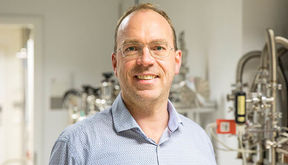Physicist Robin Ras receives 2 million euro ERC funding for research on non-wetting surfaces

Professor Robin Ras of Aalto University has been awarded a nearly 2 million euro Consolidator Grant by the European Research Council (ERC) for a project on extremely non-wetting surfaces. The aim in this five-year “Superslippery Liquid-Repellent Surfaces” project is to fabricate new surfaces and to advance their potential for technological applications for example in anti-icing and in the prevention of bio-fouling (when microorganisms or other biological materials accumulate on a surface).
Researchers at Aalto University have previously managed to develop robust and superhydrophobic, extremely non-wetting surfaces that stay dry even when immersed in water. A surface is superhydrophobic when it repels water to the degree that droplets do not stick to the surface and roll off easily.
'In this ERC project,' says Ras, 'I aim to substantially progress the development of new types of enhanced non-wetting surfaces. Additionally, I will advance characterization techniques and explore new applications for such surfaces.'
Superhydrophobic surfaces have tremendous application potential because of their anti-icing and anti-bio-fouling properties. For example, clothes, camera lenses, and phones could be kept dry and clean, as well as cars, ships, airplanes, and solar cells could stay clean of contamination and ice.
'Another potential field of application is microfluidics, where small volumes of liquid are flowing through channels, and cleanliness of the surfaces is very important. Superhydrophobic surfaces could be implemented, for example, in medical diagnostic lab-on-a-chip devices for blood testing and analysis', Ras explains.
Before practical applications can be fully developed, there are still problems waiting to be solved.
First is that surface textures are susceptible to mechanical wear, so they are easily damaged. Second, scientists and people in industry need new and standardized measurement techniques for surfaces to advance innovations.
'Besides further developing and fabricating new surfaces, we intend to create new methods to evaluate water-repellency. With this ERC project, I am very excited to contribute to the rapidly growing field of science and technology of non-wetting surfaces', Ras concludes.
A surface is superhydrophobic when it repels water to the degree that droplets do not stick to the surface and roll off easily. Photo Mika Latikka.
Further information:
Prof. Robin Ras
Department of Applied Physics, Aalto University School of Science
Centre of Excellence in Molecular Engineering of Biosynthetic Hybrid Materials
Puumiehenkuja 2, FIN-02150 Espoo, Finland
+358 50 432 6633
[email protected]
http://physics.aalto.fi/smw
http://hyber.aalto.fi/en/
Twitter: @Robin_Ras
Robin’s YouTube channel: http://www.youtube.com/user/RobinHARas
- Published:
- Updated:
Read more news

Get to know us: Associate Professor Maria Sammalkorpi
Sammalkorpi received her doctorate from Helsinki University of Technology 2004. After her defence, she has worked as a researcher at the Universities of Princeton, Yale and Aalto.
Aalto computer scientists in ICML 2024
Computer scientists in ICML 2024
In low-hierarchy organisations, even key policy issues are discussed in Slack
In a recent study, Aalto University alumn Lauri Pietinalho, a visiting scholar at New York University's Stern School of Business, and Frank Martela, an assistant professor at Aalto University, investigated how low-hierarchy organisations deal with shared policies in confrontational situations and how authority functions within them.